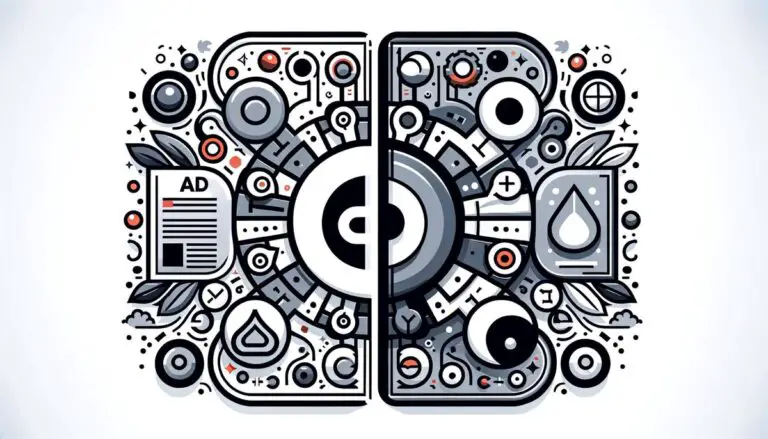In the digital landscape, the role of advertising platforms like Ezoic and Taboola is pivotal in shaping how publishers monetize their content while maintaining an engaging user experience. These platforms offer distinct approaches to online advertising, each with its own set of strategies and benefits to meet the diverse needs of digital publishers.
Overview of Ezoic and Taboola
Ezoic and Taboola operate in the field of online advertising, serving as intermediaries between publishers and advertisers. Ezoic utilizes artificial intelligence to optimize website ad layouts for publishers, aiming to enhance user experience while maximizing ad revenue. This platform allows for testing various ad configurations to identify the most effective.
On the other hand, Taboola specializes in content recommendation. Their platform helps websites capture visitor interest by suggesting relevant articles and ads based on content the user is already engaging with. Often integrated at the end of articles, Taboola's recommendations aim to increase reader stay time and click rates.
Ezoic is distinct for its comprehensive use of machine learning, not just to optimize ad placement, but also to predict and improve user interactions without sacrificing loading speeds or visual appeal. They support a variety of ad types including display, native, and in-video.
Taboola's edge is its emphasis on keeping users engaged by leveraging a vast network of content from various publishers and advertisers. This approach allows for a diverse range of ads that are contextually aligned with user interests, fostering higher engagement rates.
Exploring financial elements, Ezoic keeps a transparent revenue sharing model where they claim up to a 10% fee, leaving the majority of ad revenue with the publisher. Taboola, meanwhile, often splits the generated revenue from their native advertising fairly evenly between them and their publishers.
Both platforms provide detailed analytics tools. Ezoic offers an extensive suite of analytics that helps publishers understand a wide array of metrics related to ad performance and user behavior. Taboola's focus is on delivering insights about how content recommendations drive engagement and revenue.
Ultimately, choosing between Ezoic and Taboola will depend on the specific needs and scale of a publisher's operations. For those valuing thorough machine learning-driven layout optimization and flexibility in ad placements, Ezoic stands out. Publishers seeking robust content discovery tools that elevate user interaction might find Taboola's offerings more aligned with their goals.
Key Features Comparison
Ezoic's platform stands out through its AI-driven approach to ad optimization, which significantly customizes the ad setup based on real-time data about user behavior and site performance metrics. This AI utilizes machine learning algorithms to constantly update and fine-tune where and how ads are displayed, ensuring that publishers can achieve higher revenue and maintain an optimal balance between monetization and user experience.
Conversely, Taboola's content recommendation engine is designed to increase user engagement through targeted content suggestions that appear more organic and less like typical advertisements. This engine analyzes user preferences and browsing history to suggest relevant articles, videos, and products, keeping the audience engaged longer on the publisher's site and potentially increasing revenue through higher click-through rates.
Ezoic offers a feature called 'Ad Tester' where publishers can run A/B testing across different ad configurations to gather actionable insights. This enables publishers to make informed decisions based on comprehensive data regarding which ads perform best in terms of visitor engagement and revenue generation. Additionally, Ezoic's 'Site Speed Accelerator' ensures that the inclusion of ads does not affect the website's load time, which is a critical factor in SEO and user retention.
Taboola extends its functionality beyond simple recommendations by offering 'Taboola Feed', a social media-like scrollable feed that allows users to discover a mix of articles, videos, and sponsored content, formatted in a digestible and engaging manner. This adds to the user experience by mimicking the addictive nature of social media feeds and opens avenues for publishers to monetize non-conventional ad spaces effectively.
Both platforms also stand out in terms of analytics, giving publishers deep insights into advertisement performance and user behaviors. Ezoic's analytics are geared towards understanding how changes in ad layouts impact the overall revenue and user experience, while Taboola provides detailed reports on how users are interacting with the recommended content and the overall engagement metrics.
Ad Revenue Models
Ezoic and Taboola differ significantly when comparing their ad revenue models and payment structures, an important consideration for publishers looking to maximize their site's profitability.
Starting with Ezoic, the platform operates on a revenue-sharing model where it retains approximately 10% of the ad income generated through its placed ads while the publisher receives the remaining 90%. This clear split is straightforward and publisher-friendly, making financial planning and forecasting easier for site owners. Additionally, Ezoic's model includes a standout feature where it offers a range of payment methodologies including CPM (Cost Per Mille) and EPMV (Earnings Per Thousand Visitors), allowing publishers to choose the method that best fits their site's traffic behavior and audience engagement levels. Notably, Ezoic has no strict minimum traffic requirements to begin working with them, which democratically opens up opportunities for smaller or newer sites to use advanced A/B testing to optimize their ad revenue.
In comparison, Taboola's model hinges more heavily on traffic volume which aligns with its use of CPC (Cost Per Click) and CPM payment structures. Their revenue split with publishers typically averages around a 50/50 division, though this can vary depending on specific publisher contracts and traffic quality. Important to note is Taboola's minimum traffic requirement, which stands at a considerable line of 500,000 page views per month for a potential partner to start displaying their content-recommendation widgets. This higher barrier to entry can be a limiting factor for emerging publishers and smaller content sites eager to use such an advanced tool for driving audience engagement and monetization through customized ads.
While both platforms allow great room for analytics, which goes hand in hand with strategic adjustments and improvements, they differ in their approach where Taboola is considered slightly more rigid, sticking to standard templates partly due to the seamless blending of its widgets into client interfaces while preparing for substantial user engagement metrics.

User Experience and Engagement
Taboola employs a strategy that immerses users into a seamless content-discovery journey, mirroring social media unwind patterns embedded at the end of articles or seamlessly placed where bounce rates typically peak. Such arrangements preserve the contextual integrity of the website and prompt further exploration into the site, potentially boosting the dwell time and page engagement—curating a space where advertisements complement the editorial essence rather than disrupt it.
User experience, particularly when considering site performance, is a hallmark of Ezoic's value proposition. The platform supports a feature known as 'Site Speed Accelerator', aimed at ensuring that ad display technologies do not impede website speed—an integral SEO and user experience factor. Rapid loading times combined with optimized advertisement placements means minimized user disruption; this is crucial for maintaining audience satisfaction and ensuring repeated visits.
The analytics tools provided by both platforms allow publishers to deeply understand how users interact with the site's content – including how they engage with the displayed ads. This information is vital for continual optimization strategies aimed at enhancing user experiences while also improving ad revenues. For instance, A/B testing facilitated by Ezoic can reveal essential data on user preferences, enabling publishers to refine ad layouts, loading techniques, and even the type of ads shown, customizing the user's browsing journey to be as fluid as possible without being overly intrusive.
Market Performance and Publisher Feedback
Taboola and Ezoic have diverged paths in terms of their perceived market performance and feedback received from publishers, each shaping unique experiences characterized by their distinctive service provisions.
Ezoic notably prides itself in boosting publisher revenue through its sophisticated AI and machine learning technology—marked improvements that have not gone unnoticed. Several publishers note an uptick in their earnings shortly after implementing Ezoic's system, attributed to its relentless optimization of ad placements and layouts. The AI's ability to continually learn and adapt to user behavior ensures that ads remain appealing and effective, maximizing engagement without intruding on the user experience.
Regarding support, Ezoic appears to maintain commendable communication channels, with a focus on continual education and assisting publishers in managing their AI configurations. Their webinars, case studies, and accessible customer service are frequently cited as invaluable resources that help to demystify the interplay between ad performance optimization and user experience components.
Conversely, Taboola's platform is particularly renowned for driving impressive user engagement rates through its strategic placement of native advertising elements. Publishers utilizing Taboola often report successful increases in page views and time spent on their sites, a direct result of captivating content recommendations that hook and sustain reader interest. This can be largely associated with the quality of Taboola's content matching algorithms that possess an accuracy in predicting reader preferences.
Feedback on Taboola's ease of use remains positive, with publishers admiring the straightforward integration process of the ad widgets which harmonize seamlessly with existing content formats. However, some note the existence of a learning curve when first acclimating to the platform's various features and analytical tools—though many concede that the initial intricacy bears valuable insights and control over advertisement operations.
On balance, while both platforms are highly regarded by the publisher community and continue to refine their offerings, the choice between Ezoic and Taboola often boils down to specific publisher priorities—whether the aim is to enhance site monetization through smart technological integrations or to extend user engagement and page metrics through intuitive content suggestions.
Future Outlook and Technological Advancements
Looking forward, the digital advertising space is poised to witness significant shifts driven by technological evolution and changing market dynamics. For platforms like Ezoic and Taboola, staying ahead means continuously innovating to meet the growing demands of publishers and changing consumption patterns of users.
Ezoic could integrate more advanced forms of AI and machine learning to provide deeper insights into user behavior and offer more granular ad customization. This could involve predicting user engagement based on browsing patterns and dynamically adjusting ads to match these predictions. Ezoic could also expand its machine learning capabilities to better handle image-heavy content and video.
Taboola, on the other hand, is likely to enhance its content recommendation engine beyond traditional text-based advertisements and articles. This could involve stepping deeper into multimedia content, such as interactive ads or augmented reality content, to increase user engagement and session times. Taboola could also improve its algorithm to offer more personalized ad experiences at a hyper-local level, tapping into local business advertising and events.
Both platforms have the potential to enhance their analytics capabilities with AI that provides predictive insights, not just reporting on past activities. This could mean advanced warnings about dropping engagement levels, suggestions for optimal content production schedules, or even AI-generated content tips customized to specific demographics.
As privacy concerns continue to shape online advertising rules and public sentiment, both platforms need to innovate ways to personally customize advertisements while adhering to stricter data usage regulations. Innovations in federated learning, a machine learning technique that trains algorithms across decentralized devices without exchanging sensitive user information, could become a critical area of focus.
The future trajectory for both Ezoic and Taboola seems poised at an interesting juncture where adapting to and integrating new technologies could majorly dictate their popularity and usability among publishers in a competitive market landscape. The race is on, not just to keep up with current trends but to anticipate and shape future ones, ensuring these platforms remain indispensable tools for publishers navigating the digital space.

In conclusion, the choice between Ezoic and Taboola depends on the specific requirements and goals of publishers. Ezoic provides sophisticated ad layout optimization and flexibility, while Taboola excels in enhancing user engagement through its advanced content recommendation engine. Each platform offers unique capabilities that can significantly influence a publisher's ability to generate revenue while maintaining a positive user experience.
As the digital advertising landscape continues to evolve, both Ezoic and Taboola are well-positioned to adapt and innovate, integrating cutting-edge technologies like AI and machine learning to provide more personalized and effective advertising solutions. Publishers must carefully consider their priorities and target audience when deciding between these two platforms, as the right choice can have a substantial impact on their success in the competitive world of online publishing.



